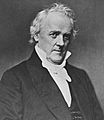Ostend manifesto facts for kids
The Ostend Manifesto was an important paper written in 1854. It explained why the United States should try to buy Cuba from Spain. At that time, many people in the U.S. wanted to expand the country. They also wanted to add more states where slavery was allowed. Cuba was seen as a place that could become a new slave state.
Contents
What Was the Ostend Manifesto?
The Ostend Manifesto was a secret document. It was written by three American diplomats. These diplomats were the U.S. ministers (like ambassadors) to Spain, France, and Great Britain. They met in Ostend, Belgium, and later in Aix-la-Chapelle, Prussia. Their goal was to discuss how the U.S. could get Cuba.
Why Did the U.S. Want Cuba?
The United States had wanted to buy Cuba for many years. Cuba was very close to Florida. It was also a rich island that produced a lot of sugar. Many people in the Southern U.S. believed that Cuba would be a good place to expand slavery. They thought it would help their economy.
Some Americans also worried that Cuba might become a free country. If Cuba became independent, they feared it could lead to slave revolts in the U.S. Southern states. Buying Cuba seemed like a way to prevent this.
Who Wrote the Document?
The main people who wrote the Ostend Manifesto were:
- James Buchanan, the U.S. Minister to Great Britain (who later became president).
- John Y. Mason, the U.S. Minister to France.
- Pierre Soulé, the U.S. Minister to Spain.
They were all strong supporters of expanding the United States. They also believed that slavery should be allowed to grow.
The Main Ideas of the Manifesto
The Ostend Manifesto said that the U.S. should offer a lot of money to Spain for Cuba. If Spain refused to sell, the document suggested that the U.S. might be justified in taking Cuba by force. This idea was very controversial. The manifesto argued that if Spain's control over Cuba was a danger to the U.S., then the U.S. had a right to act.
Why Was It Controversial?
When the Ostend Manifesto became public, it caused a big uproar. Many people in the Northern U.S. were very angry. They saw it as a plan to expand slavery and increase the power of slave states. They also thought it was wrong to threaten another country.
The document was quickly rejected by the U.S. government. It was seen as a scandal. The U.S. Secretary of State, William Marcy, told the diplomats that the U.S. would not follow the ideas in the manifesto.
What Happened After the Manifesto?
The Ostend Manifesto never led to the U.S. buying or taking Cuba. Instead, it made the tensions between the North and South even worse. It showed how deeply divided the country was over the issue of slavery.
The manifesto became a symbol of the South's desire to expand slavery. It also showed the North's strong opposition to it. This disagreement over slavery eventually led to the American Civil War a few years later.
The Ostend Manifesto is an important part of American history. It helps us understand the complex reasons behind the Civil War. It shows how the debate over slavery affected U.S. foreign policy and national goals.
Images for kids
-
James Buchanan is believed to have authored the document.
See also
 In Spanish: Manifiesto de Ostende para niños
In Spanish: Manifiesto de Ostende para niños




